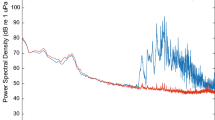Abstract
Behavioral and geographic variation in animal communication has been well-studied in insects, frogs, birds, and mammals, but little is known about variation in fishes. We used underwater audio-video recordings of the behavior and associated sounds produced by the domino damselfish, Dascyllus albisella, at Johnston Atoll and Hawaii, which are separated by 1000 km, to study behavioral and geographic variation in communication sounds. Males produced pulsed sounds during the courtship behavior known as the signal jump, visiting by females (during pseudospawning), mating, aggression to heterospecifics and conspecifics, and nest preparation. Females made only aggressive sounds. The following features of the sounds were measured: number of pulses, pulse rate, pulse duration, inter-pulse interval, dominant frequency, and frequency envelope. The only difference between visiting and mating sounds was a small difference in pulse duration. Two types of aggressive sounds were produced, pops and chirps. Pops contained only one or two pulses and were more commonly made towards heterospecifics than conspecifics. Aggressive chirps had between 3–11 pulses and were made most often towards conspecifics. The pulse rate of aggressive chirps was faster than signal jump sounds. The only difference in signal jump sounds made by males from Johnston Atoll and Hawaii, was a small difference in pulse duration, which was likely due to differences in the depths of the recording environment and not in the sounds produced.
Similar content being viewed by others
References cited
Amorim, M.C.P.D. 1996. Sound production in the blue-green damselfish, Chromis viridis (Cuvier, 1830) (Pomacentridae). Bioacoustics 6: 265–272.
Chen, K.-C. & H.-K. Mok. 1988. Sound production in the anemonefishes, Amphiprion clarkii and A. frenatus (Pomacentridae), in captivity. Japan. J. Ichthyol. 35: 90–97.
Claridge, M.F. & J.C. Morgan. 1993. Geographical variation in the acoustic signal of the planthopper, Nilaparvata bakeri (Muir), in Asia: species recognition and sexual selection. Biol. J. Linn. Soc. 48: 267–281.
Ewing. 1989. Arthropod bioacoustics: neurobiology and behaviour. Cornell University Press, Ithaca. 260 pp.
Fay, R.R. & S. Coombs. 1983. Neural mechanisms in sound detection and temporal summation. Hear. Res. 10: 69–92.
Fine, M.L. 1978. Seasonal and geographical variation of the mating call of the oyster toadfish Opsanus tau L. Oecologia 36: 45–57.
Gerald, J.W. 1971. Sound production during courtship in six species of sunfish (Centrarchidae). Evolution 25: 75–87.
Godwin, J. 1995. Phylogenetic and habitat influences on mating system structure in the humbug damselfishes (Dascyllus, Pomacentridae). Bull. Mar. Sci. 57: 637–652.
Grant, B.R. & P.R. Grant. 1989. Evolutionary dynamics of a natural population. Chicago University Press, Chicago. 350 pp.
Ha, S.J. 1973. Aspects of sound communication in the damselfish Eupomacentrus partitus. Ph.D. Thesis, University of Miami, Miami. 78 pp.
Holzberg, S. 1973. Beobachtungen zur Ökologie und zum socialverhalten des Korallenbarsches Dascyllus marginatus Ruppell (Pisces; Pomacentridae). Z. Tierpsychol. 33: 492–513.
Kenyon, T.N. 1994. The significance of sound interception to males of the bicolor damselfish, Pomacentrus partitus, during courtship. Env. Biol. Fish. 40: 391–405.
Lobel, P.S. 1996. Spawning sound of the trunkfish, Ostracion meleagris (Ostraciidae). Biol. Bull. 191: 308–309.
Lobel, P.S. & D.A. Mann. 1995. Spawning sounds of the domino damselfish, Dascyllus albisella (Pomacentridae), and the relationship to male size. Bioacoustics 6: 187–198.
Luh, H.K. & H.K. Mok. 1986. Sound production in the domino damselfish Dascyllus trimaculatus (Pomacentridae) under laboratory conditions. Japan. J. Icthyol. 33: 70–74.
Mann, D.A. & P.S. Lobel. 1995. Passive acoustic detection of sounds produced by the damselfish, Dascyllus albisella (Pomacentridae). Bioacoustics 6: 199–213.
Mann, D.A. & P.S. Lobel. 1997. Propagation of damselfish (Pomacentridae) courtship sounds. J. Acoust. Soc. Amer. 101: 3783–3791.
Morton, E. 1977. On the occurrence and significance of motivation-structural rules in some bird and mammal species. Amer. Nat. 111: 855–869.
Morton, E. & J. Page. 1992. Animal talk. Random House, New York. 275 pp.
Myrberg, A.A., Jr. 1972. Ethology of the bicolor damselfish, Eupomacentrus partitus (Pisces: Pomacentridae): a comparative analysis of laboratory and field behavior. Anim. Behav. Mon. 5: 197–283.
Myrberg, A.A., Jr., E. Kramer & P. Heinecke. 1965. Sound production by cichlid fishes. Science 149: 555–558.
Myrberg, A.A., Jr., M. Mohler & J.D. Catala. 1986. Sound production by males of a coral reef fish (Pomacentrus partitus): its significance to females. Anim. Behav. 34: 913–923.
Myrberg, A.A., Jr., Ha, S.J. & M.J. Shamblott. 1993. The sounds of bicolor damselfish (Pomacentrus partitus): predictors of body size and a spectral basis for individual recognition and assessment. J. Acoust. Soc. Amer. 94: 3067–3070.
Nelissen, M.H.J. 1977. Sound production by Haplochromis burtoni (Gunther) and Tropheus boulenger (Pisces, Cichlidae). Annales Soc. R. Zool. Belg. 106: 155–166.
Nelissen, M.H.J. 1978. Sound production by some Tanganyikan cichlid fishes and a hypothesis for the evolution of their communication mechanisms. Behav. 64: 137–147.
Randall, H.A. & G.R. Allen. 1977. A revision of the damselfish genus Dascyllus (Pomacentridae) with the description of a new species. Records of the Australian Museum 31: 349–385.
Randall, J.E., P.S. Lobel & E.H. Chave. 1985. Annotated checklist of the fishes of Johnston Island. Pac. Sci. 39: 24–80.
Ryan, M.J. & A.S. Rand. 1993. Species recognition and sexual selection as a unitary problem in animal communication. Evolution 47: 647–657.
Spanier, E. 1970. Analysis of sounds and associated behavior of the domino damselfish Dascyllus trimaculatus (Ruppell, 1828) (Pomacentridae). M.Sc. Thesis, Tel-Aviv University, Tel-Aviv. 80 pp.
Spanier, E. 1979. Aspects of species recognition by sound in four species of damselfishes, genus Eupomacentrus (Pisces: Pomacentridae). Z. Tierpsychol. 51: 301–316.
Wells, M.M. & C.S. Henry. 1992. The role of courtship songs in reproductive isolation among populations of green lacewings of the genus Chrysoperla (Neuroptera: Chrysopidae). Evolution 46: 31–42.
Wilczynski, W., A. C. Keddy-Hector & M.J. Ryan. 1992. Call patterns and basilar papilla tuning in cricket frogs. I. Differences among populations and between sexes. Brain Behav. Evol. 39: 229–237.
Author information
Authors and Affiliations
Rights and permissions
About this article
Cite this article
Mann, D.A., Lobel, P.S. Acoustic behavior of the damselfish Dascyllus albisella: behavioral and geographic variation. Environmental Biology of Fishes 51, 421–428 (1998). https://doi.org/10.1023/A:1007410429942
Issue Date:
DOI: https://doi.org/10.1023/A:1007410429942




